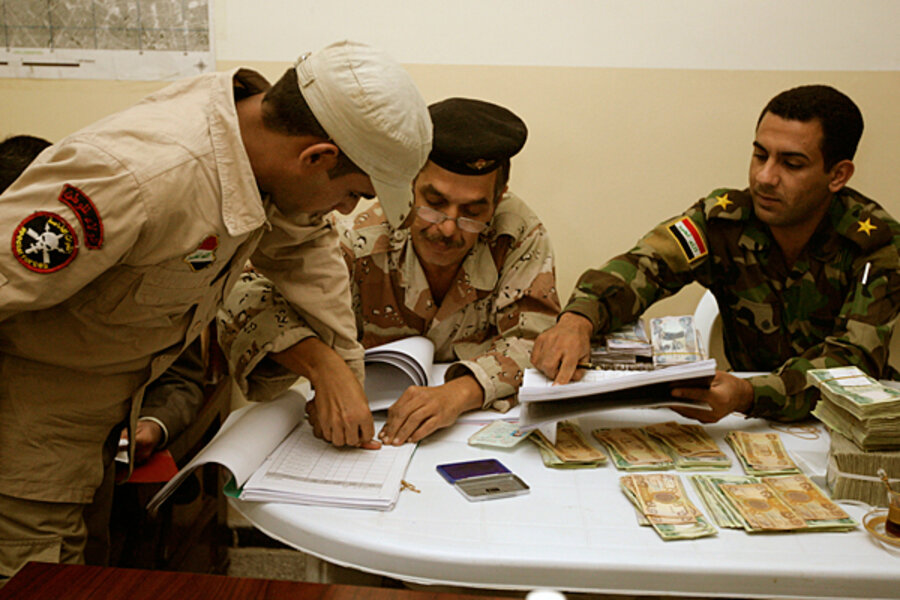Rebuilding Iraq: Final report card on US efforts highlights massive waste
Loading...
| Washington
The US reconstruction operations in Iraq constituted the largest project of its kind ever undertaken by America, but it was plagued by a host of challenges, including corruption and waste, that cast a poor light on the US ability to undertake such projects, the author of the official report on the program told Congress this week.
“For all of the good intentions, it was a program replete with challenges, over-promises, setbacks, and shortcomings,” the Republican chairman of the House Middle East subcommittee, Rep. Ileana Ros-Lehtinen of Florida, noted in the hearing Thursday.
These efforts have been plagued by waste, too, of much of the $60 billion in US taxpayer money used to fund the rebuilding of Iraq, agreed Rep. Ted Deutch (D) of Florida in a rare moment of robust bipartisan unity.
At the same time, private defense contractors, which had some 170,000 employees on the ground, reaped some $140 billion in profits in Iraq, he said. Some of these profits came from flagrant overcharging, such as the contractor that billed the US government $900 for a switch that was valued at $7.05, a 12,000 percent markup.
Here are five of the most wasteful projects uncovered in “Learning from Iraq: A Final Report from the Special Inspector General for Iraq Reconstruction,” which summarized 220 audits and 170 inspection reports over nearly a decade and “painted a very grim picture of our ability to adequately plan, execute, and oversee large-scale stability and reconstruction operations.”
Water treatment
Water projects resulted in “some of the costliest US-funded reconstruction efforts in the entire program,” the report noted. Indeed, three treatment plants throughout the country cost the US government a total of $545 million.
The goal of the Coalition Provincial Authority (CPA) goal was to increase access to drinkable water to 90 percent of Iraqis. The State Department later determined “these goals to be unrealistic, because there was no baseline data on Iraq’s water and sanitation infrastructure,” the special inspector general (SIGIR) found.
As a result, in Fallujah, for example, a $30 million project tripled in cost to nearly $100 million, and only reached one-third of the homes it was originally intended to serve.
In 2005, the US government partnered with the Iraqi government to improve a dam in the northern Iraq city of Mosul, funding 21 contracts worth $27 million. When SIGIR inspectors visited the dam in 2007, they found that the project was poorly designed and that $19 million worth of equipment bought to improve the dam wasn’t being used.
Sons of Iraq
The widely hailed Sons of Iraq (SOI) program, which paid former Sunni insurgents to lay down their arms beginning in 2007, was one of the Pentagon's most widely funded programs. The US military used what were known as Commanders’ Emergency Response Program (CERP) funds to pay chiefs to keep their people off the battlefields.
The CERP contracts amounted to 780 separate agreements calling for the stationing of 100,000 Sunnis across Iraq, for a total of $370 million in CERP funds. The workers were supposed to take jobs “providing security for buildings, checkpoints and battlefield.”
Yet the contracting process “was far from transparent,” SIGIR noted. “Program managers could not tell whether SOI members received their US-funded salaries, and Defense was unable to provide any evaluations of the program’s outcomes.”
In short, it concluded, “Financial controls were weak.”
Children's hospital
This was the largest individual health-care construction project, which USAID awarded to the defense contractor Bechtel in 2004 for $50 million. The hospital was supposed to be a state-of-the-art pediatric cancer-treatment facility.
“Work moved slowly,” however, according to the SIGIR report. “Deteriorating security, bad site conditions, and poor contractor performance pushed up costs and pushed out the completion date.”
By 2008 the contract had been terminated. The hospital was completed with new funds in 2010 and opened for “limited treatment,” with standards far below the original state-of-the-art visions for a project that would eventually cost the US government $165 million.
First responder network
In March 2004, the US government decided to help contribute to an “advanced first responder network” in Iraq, and ultimately spent more than $192 million to do it.
A 2006 SIGIR audit found, however, that the project had “failed to produce a reliable” system, largely because the “network’s command and control system did not provide an effective means for dispatching and directing first responders.”
The good news was that a SIGIR audit helped encourage the contractor to remedy many deficiencies of the system, and a 2012 whistle-blower lawsuit meant that the contractor reimbursed the US government $4 million after it was found guilty of submitting false testing certifications designed to mislead the US Army about the effectiveness of the system.
Building Iraqi security forces
In examining contracts awarded to build the Iraqi Army, totaling $628 million, SIGIR found that several of them had been modified 161 times, “which added $420 million to the contracts’ cost,” the report noted.
SIGIR auditors also found that many contractors never provided documentation to support their reported costs, and that when they did, the “financial data on purchases did not reconcile.”
Although some contracts provided logistics support to the Iraqi Army, “the effort fell well short of achieving the goal of training Iraqi Army personnel to maintain their equipment," SIGIR found. Today, it concludes, the culture of “Use it ‘til it breaks’ lives on.”







